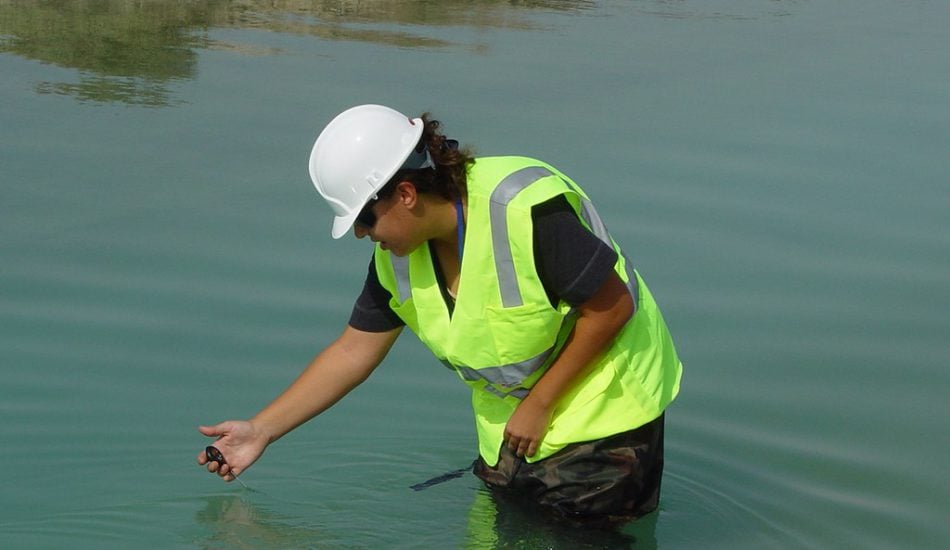
Surface water quality
As indicated in previous sections, Bahrain has no surface water resources.
Groundwater quality
Prolonged overexploitation of the Dammam aquifer has resulted in water level decline (Figure 1). As a direct consequence, saltwater bodies (seawater and underlying brackish/saline water in the Rus-UER layer) have migrated into the aquifer, leading to a continuous salinization and deterioration of the groundwater quality. Currently, most of the original groundwater reservoir has been lost to salinization, except for a small strip on the north-west of Bahrain Island where the Dammam aquifer’s salinity is less than 3,500 mg/L. Map 1 illustrates the observed 2015 salinity distribution in the Khobar member of the Dammam aquifer.

The salinity of the non-renewable Rus-UER aquifer has remained more or less constant since the beginning of its use at a relatively major scale in 1984 by the industrial sector and in feeding the Ras Abu Jarjur reverse osmosis desalination plant. Figure 1 displays the average salinity (in terms of total dissolved solids).
Drinking water and wastewater quality
Faced with groundwater quality deterioration and escalating municipal water demand, the municipal water authorities implemented a policy that in the mid-1980s started to reduce the reliance on groundwater in the municipal water supply by increasing desalinated water input to meet the standards of drinking water. Figure 2 displays the salinity of the municipal water supply for the period 1985-2015. Major improvements in the salinity in 1999, 2008 and 2014 correspond with major desalination expansion.
The current sanitation system covers most of Bahrain and consists of 127.5 km of trunk sewers, 1,228.3 km of secondary sewers, 1,822 km of lateral sewers including house connections, 85.2 km of pressure lines and 631 pumping and lifting stations.
Figure 1: Average salinity (total dissolved solids) of the Rus-UER aquifer measured in aquifer observation wells, 2006-2016. Red color line represents the average TDS.
Figure 2: Total dissolved solids of municipal water, in mg/L.
The current sanitation system covers most of Bahrain and consists of 127.5 km of trunk sewers, 1,228.3 km of secondary sewers, 1,822 km of lateral sewers including house connections, 85.2 km of pressure lines and 631 pumping and lifting stations. The sewer discharge network catches infiltration wastes and raw sewage from households and different establishments and transports it to the wastewater treatment plants. Presently, about 90% of the population has access to sanitation services. The sewerage systems were built as conventional gravity flow systems with intermittent lift stations to limit the system depth to about 7 metres. The existing sewer network has a total length of approximately 2,962 km.
One of the main constraints for treated wastewater reuse in the past was its high salinity, reaching about 4,000 mg/L, which was the result of two factors: high infiltration rates to the collection network by shallow groundwater and relatively high salinity of municipal water. In response, the Ministry of Works, Municipalities Affairs and Urban Planning embarked in 2011 on a countrywide staged programme to reduce the infiltration rates, which is still ongoing. Since 2008, a major improvement in the salinity of the supplied municipal water has occurred due to the expansion in desalination capacity and reduced reliance on brackish groundwater. Figure 2 illustrates the improvement trends of salinity in raw, secondary treated and tertiary treated wastewater for the period 1985-2015.
Environmental and health risks
The major environmental and health risks associated with water sector activities are the environmental impacts of desalination plants on the marine and air environments and the discharge of partially treated/untreated wastewater and sludge to the marine environment.
Environmental impacts of desalination plants
While Bahrain has been able to meet the rising municipal water demand in quantity and quality by expanding desalination plant production, this has not only been associated with financial and economic costs (e.g. depletion of gas reserves) but also with relatively high environmental costs. These are manifested in the discharge of elevated temperature brines to the surrounding coastal and marine environment as well as gaseous emissions to the surrounding air environment.
Wastewater treatment
Prior to 2014, Bahrain adopted a centralized wastewater system, i.e. relying on one centralized wastewater treatment plant (Tubli WPCC) to treat all generated urban wastewater in the country. This resulted in the system frequently receiving hydraulic loads that exceeded its designed capacity, leading to large carryover volumes of partially treated wastewater (and sometimes untreated wastewater) to the surrounding marine and coastal environment. In addition to the pollution of the surrounding environment, a frequent fish kill occurred in the discharge area, and concerns were raised about the health and environmental safety of the adjacent residential areas.
However, in 2014, a new decentralization policy was adopted that saw the operation of the Muharraq wastewater treatment plant (private sector). In addition, plans to expand, upgrade and modernize existing sewage treatment plants are underway, which are expected to reduce the hydraulic loading problems as these plans are implemented.
